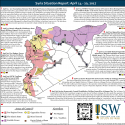 |
 |
Syria Situation Report: April 14 - 20, 2017

Russia, Iran, and Syria demonstrated their enduring partnership during a trilateral foreign ministerial meeting in Moscow on April 14 to discuss their response to the recent strike by the U.S. against Shayrat Airbase in Syria on April 6. The ministers stressed the three countries share “common procedures against any aggression” and expressed concern regarding expanded deployments by the U.S. to the Syrian-Jordanian Border. Meanwhile, activists and anonymous officials continued to report the consolidation of pro-regime warplanes onto former civilian airfields – including the Bassel al-Assad International Airport in Latakia Province – in anticipation of any future strikes by the U.S. in Syria.
Syrian President Bashar al-Assad continued to consolidate his grip around core regime terrain in Damascus and Hama City. Buses evacuated over two thousand opposition fighters and civilians from the besieged towns of Zabadani and Madaya near Damascus in exchange for the evacuation of nearly eight thousand pro-regime fighters and civilians from the besieged towns of Fu’ah and Kefraya in Idlib Province. The evacuations come as part of a broader deal brokered by Iran and Qatar that includes population transfers, prisoner releases, and the release of a member of the Qatari Royal Family kidnapped in Iraq in 2015. Pro-regime forces also reversed all of the gains achieved by opposition forces in Northern Hama Province since the start of a major offensive against Hama City on March 21.
Finally, Turkish President Recep Erdogan achieved his longstanding goal to solidify his political dominance. Turkey voted by a narrow margin on April 16 to approve a controversial constitutional referendum to implement an executive presidential system amidst allegations of widespread fraud as well as condemnations from international observers. Erdogan has long pursued constitutional reform to concentrate executive power within his hands. The disputed results will likely generate additional domestic and regional instability as Erdogan defends his claims to a nationwide mandate and attempts to bolster the stability of his fracturing nationalist electoral coalition – potentially by launching new military operations against Kurds in Iraq and Syria.